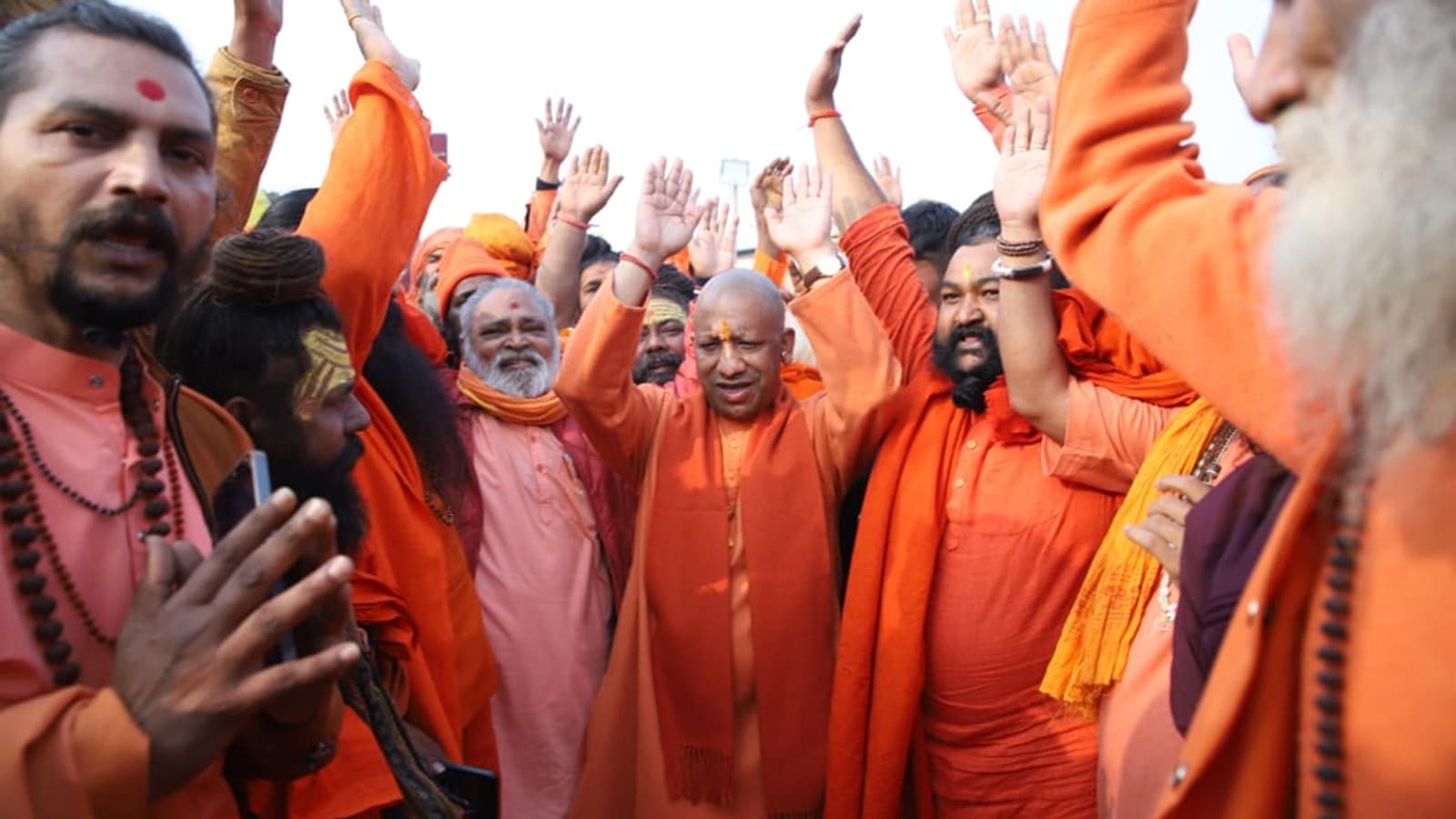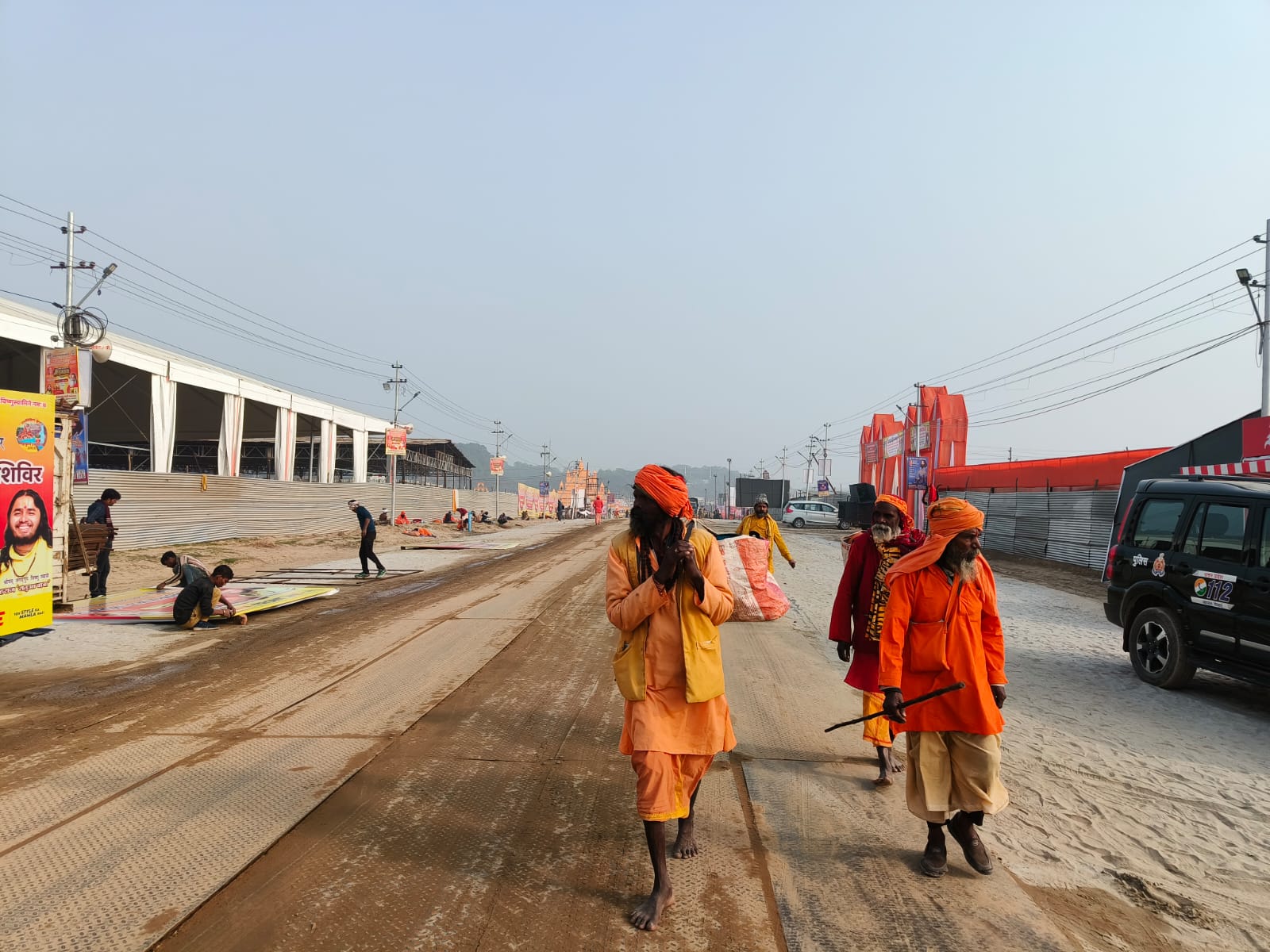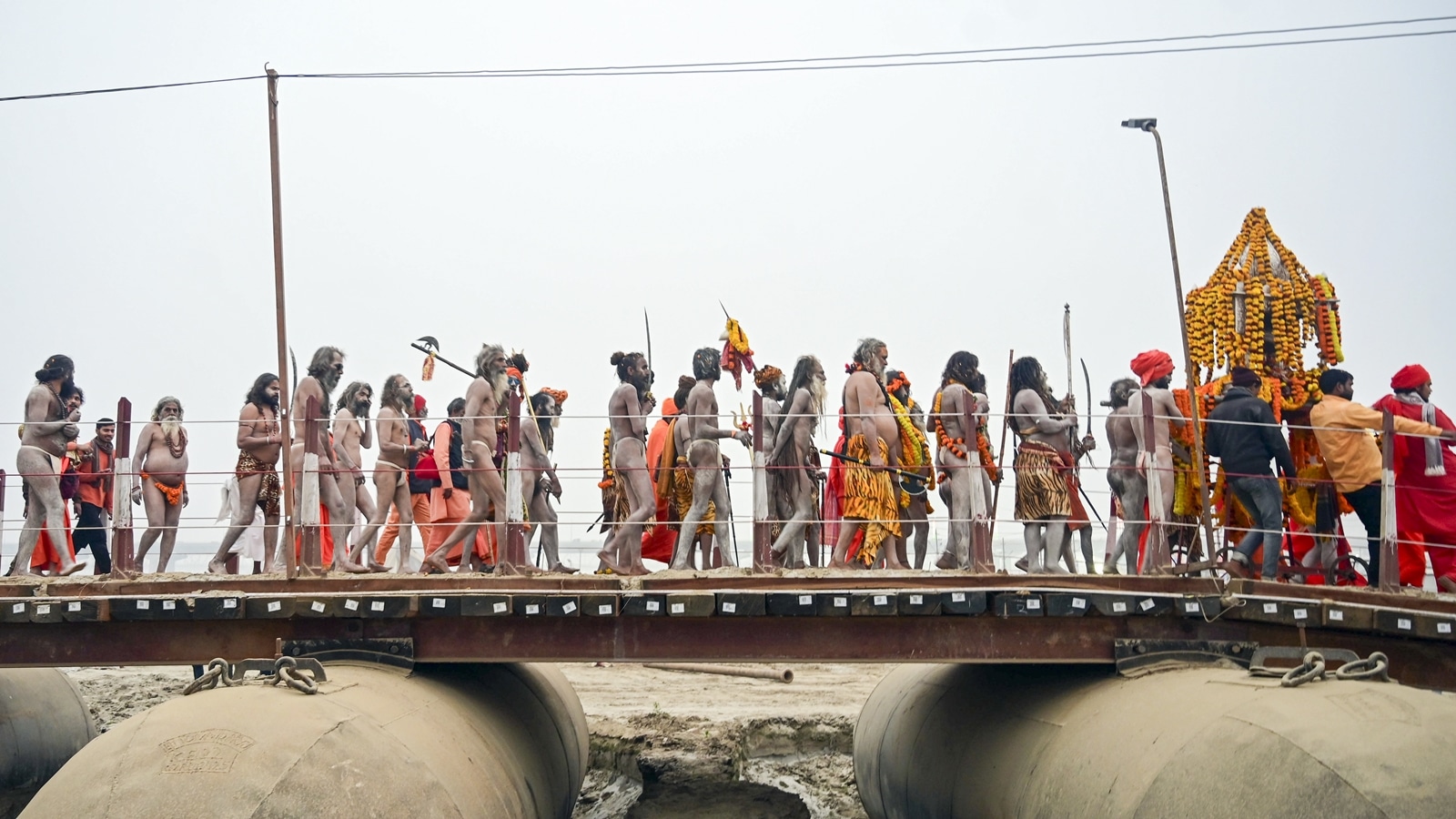Petal shower to chopper ride to holy dip, stage set for start of Maha Kumbh today
Maha Kumbh 2025: An estimated 45 crore people are expected to visit Prayagraj over next 45 days.
 A total of 40 crore pilgrims are expected to visit during Maha Kumbh 2025 and out of this 5 crore pilgrims are anticipated on Mauni Amavasya alone on January 29. (Express photo by Vishal Srivastav)
A total of 40 crore pilgrims are expected to visit during Maha Kumbh 2025 and out of this 5 crore pilgrims are anticipated on Mauni Amavasya alone on January 29. (Express photo by Vishal Srivastav)Maha Kumbh 2025, expected to bring over 45 crore people to Prayagraj over a period of one-and-a-half months, will begin on Monday with the first snan, or holy bath.
Even before the Kumbh officially began, the Sangam — the meeting point of the rivers Ganga, Yamuna and the mythical Saraswati — witnessed a huge gathering of pilgrims. According to officials, around 50 lakh people took the holy bath at the Sangam in Prayagraj on Sunday.
The Uttar Pradesh government’s Horticulture Department has made preparations to shower flower petals on pilgrims on all major snan days, starting Monday. Over 20 quintals of rose petals will be used for this purpose and they will be showered over an area of 4,000 hectares, officials said.
The Tourism Department has announced the start of a special helicopter ride from Monday onwards to witness the Kumbh. This will be priced at Rs 1,296.
According to officials, all 13 Akharas that take part in the Kumbh have entered the Kumbh site with their processions.
 The Maha Kumbh Mela, which takes place every 12 years, will be held in January of this year at the Triveni Sangam at Prayagraj. (Express photo by Dheeraj Mishra)
The Maha Kumbh Mela, which takes place every 12 years, will be held in January of this year at the Triveni Sangam at Prayagraj. (Express photo by Dheeraj Mishra)
Visitors to Prayagraj for the Kumbh have come from across the country and from different parts of the world. Among them was Laurene Powell Jobs, wife of Apple co-founder Steve Jobs.
Five major snan will start with the first one on Paush Purnima, which is Monday, followed by three rituals known as Shahi or Amrit Snan, which will take place on Makar Sankranti on Tuesday (January 14), Mauni Amavasya on January 29, and Basant Panchami on February 3. Subsequently, the remaining major snan will be on Magh Purnima on February 12 and the last one will be on Maha Shiv Ratri, which is February 26.
 Uttar Pradesh Chief Minister Yogi Adityanath at the Maha Kumbh venue in Prayagraj on Thursday. (Express photo by Vishal Srivastav)
Uttar Pradesh Chief Minister Yogi Adityanath at the Maha Kumbh venue in Prayagraj on Thursday. (Express photo by Vishal Srivastav)
NDRF, SDRF and PAC teams will be deployed on 700 flagged boats to ensure the safety of the devotees, along with the placing of remote life-saving buoys on a large scale, officials said.
Among the preparations made for the massive event by the Uttar Pradesh government is the roping in of experts from IIT Kanpur to provide cyber security and help with crowd control as well as traffic management.
 As Prayagraj prepares for the arrival of nearly 40 crore pilgrims during the 45-day mela, the city is undergoing a complete overhaul. (Express photo by Dheeraj Mishra)
As Prayagraj prepares for the arrival of nearly 40 crore pilgrims during the 45-day mela, the city is undergoing a complete overhaul. (Express photo by Dheeraj Mishra)
With the digital landscape changing considerably in the 12 years since Maha Kumbh was last held, the state government is anticipating a bigger threat this time from social media rumours and online frauds.
The institution has also established a control room with a mechanism to immediately alert the Kumbh Mela authorities and police about any social media posts that pose a potential threat to security or crowd management.
 Sadhus of Shri Taponidhi Anand Akhara Panchayati participate in the ‘Peshwai’ procession, in Prayagraj. (PTI/File)
Sadhus of Shri Taponidhi Anand Akhara Panchayati participate in the ‘Peshwai’ procession, in Prayagraj. (PTI/File)
Moreover, as the government has declared this year’s Maha Kumbh the “digital Kumbh” – at least nine different mobile applications have been launched to assist visitors and records regarding the deployment of police personnel have been digitised – it has also sought the help of the IIT to scan all these digital portals for any possible threat of hacking. The IIT has also been asked to screen all the sensors and scanners installed at the Kumbh sites.
 Monitored by over 2,750 CCTV cameras bolstered by AI to track the movement of the anticipated 40 crore pilgrims, this Kumbh will be the largest face recognition exercise in the country thus far. (Express photo by Vishal Srivastava)
Monitored by over 2,750 CCTV cameras bolstered by AI to track the movement of the anticipated 40 crore pilgrims, this Kumbh will be the largest face recognition exercise in the country thus far. (Express photo by Vishal Srivastava)
There is also the fear of pilgrims falling prey to scammers who provide fake links for services related to these apps, and the IIT experts have been asked to help prevent this, too.
IIT Kanpur director Manindra Agrawal told The Indian Express, “At any such large event, if rumours start floating, it will have consequences. Considering the bigger role that social media plays today in comparison to the past, we have assisted in setting up mechanisms to track any such potential threats on social media. Major social media platforms will be tracked for Maha Kumbh and Prayagraj-related posts or hashtags and immediate alerts will be given to mela authorities regarding suspected material for quick action on them.”
According to sources, one of the main objectives is to prevent stampede-like situations that could arise due to the circulation of wrong information. For this, efforts will be made not just to fact-check, but also to stop the spread of such misinformation as early as possible at the source.
 Langars organized by the different Akharas for people attending the Maha Kumbh in Prayagraj. (Express Photo by Vishal Srivastav)
Langars organized by the different Akharas for people attending the Maha Kumbh in Prayagraj. (Express Photo by Vishal Srivastav)
Agrawal said a control room has been established at IIT Kanpur, where experts will monitor social media and Kumbh-related apps launched by the government for potential frauds and hacking.
“We are also providing assistance with cyber security. Considering that this year’s is a ‘Digital Kumbh’, to prevent it from digital attack, there are people continuously working with system operations to ensure that the Kumbh’s digital network does not fall pray to breakdowns and critical information is not leaked,” he said. “Teams are constantly checking several apps for any potential weaknesses. There have been already a couple of rounds of analyses.”
 Prefabricated toilets are being set up for the Maha Kumbh in Prayagraj. (Express Photo by Vishal Srivastav)
Prefabricated toilets are being set up for the Maha Kumbh in Prayagraj. (Express Photo by Vishal Srivastav)
Apart from the Maha Kumbh’s website and mobile applications, the government has also launched an AI-based chatbot, integrated the Kumbh Mela map with Google Maps, and created a “QR-based pass management system” for visitors.
Officials said the IIT is also helping with traffic and crowd management by analysing data and scanning real-time footage available through CCTV cameras and drones to assist in decision-making.
“Managing train movement becomes a challenge, considering the large number of people who will be arriving. So, by analysing camera feeds, we have come up with a prediction model that can inform authorities in advance about possible overcrowding at the railway station or any other area to assist in decision-making,” Agrawal said.
 Sadhus of ‘Shree Mahanirvani Akhada’ take part in the ‘Chavni Pravesh’, the royal entry procession for Maha Kumbh. (PTI/File)
Sadhus of ‘Shree Mahanirvani Akhada’ take part in the ‘Chavni Pravesh’, the royal entry procession for Maha Kumbh. (PTI/File)
Around 2,750 CCTV cameras have been installed and drones deployed at Kumbh Mela sites to monitor the crowd movement. Apart from this, 268 systems for AI-powered “video analytics” have also been set up to monitor the crowd, while another 240 such systems have been set up to the count vehicles that come for the mela. There are also monitoring centres on the ground for round-the-clock viewing of live feeds.
IIT Kanpur has also been tasked with conducting an overall study of Maha Kumbh 2025 and submitting a report on the management of the mega event, including on what worked and what needs to be improved while managing such future gatherings. This report will be compiled after monitoring the proceedings for the whole duration of the event.







